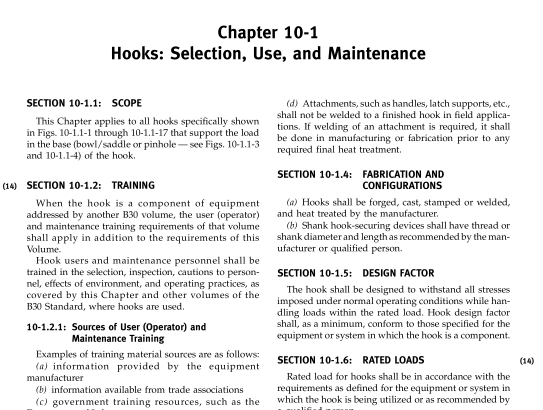ASME B30.10-2014 pdf free download.Chapter 10-1 Hooks: Selection, Use, and Maintenance
10-1.10.4 Periodic Inspection
(a) A complete inspection of the hook shall be per- formed. Disassembly may be required. The hook shall be examined for conditions such as those listed in para. 10-1.10.5.
(b) Periodic Inspection Frequency. Periodic inspection intervals shall not exceed 1 yr exce
pt as approved by a qualified person. The inspection intervals should be based on
(1) frequency of hook use
(2) severity of service conditions
(3) nature of load handling activities
(4) experience gained on the service life of hooks used in similar circumstances
(5) guidelines for the time intervals
(a) normal service — yearly with equipment in place (b) heavy service — semiannually, with equip- ment in place unless external conditions indicate that disassembly should be done to permit detailed inspec- tion monthly to quarterly
(c) severe service —quarterly, as in heavy service [see para. 10-1.10.4(b)(5)(b)], except that the detailed inspection may show the need for a nondestructive type of testing
(c) Hooks shall not be returned to service until approved by a qualified person.
(d) Written records are required. 10-1.10.5 Removal Criteria Hooks shall be removed from service if damage such as the following is visible and shall only be returned to service when approved by a qualified person:
(a) missing or illegible hook manufacturer’s identifi- cation or secondary manufacturer’s identification (b) missing or illegible rated load identification
(c) excessive pitting or corrosion
(d) cracks, nicks, or gouges
(e) wear — any wear exceeding 10% (or as recom- mended by the manufacturer) of the original section dimension of the hook or its load pin
(f) deformation — any visibly apparent bend or twist from the plane of the unbent hook
(g) throat opening — any distortion causing an increase in throat opening of 5% not to exceed 1 ⁄ 4 in. (6 mm) (or as recommended by the manufacturer)
(h) inability to lock — any self-locking hook that does not lock
(i) inoperative latch (if required) — any damaged latch or malfunctioning latch that does not close the hook’s throat (j) damaged, missing, or malfunctioning hook attach- ment and securing means
(k) thread wear, damage, or corrosion
(l) evidence of excessive heat exposure or unautho- rized welding
(m) evidence of unauthorized alterations such as drilling, machining, grinding, or other modifications
10-1.10.6 Repairs and Modifications
(a) Any conditions disclosed by the inspections performed in accordance with the requirements of para.
10-1.10.3 or 10-1.10.4 shall be corrected by repair or replacement before continuing to use the hook. All repairs and modifications shall be approved by the man- ufacturer or a qualified person.
(b) Hooks having damage or wear described as fol- lows shall be repaired or replaced:
(1) cracks, nicks, and gouges. Repair of cracks, nicks, and gouges shall be carried out by a designated personbygrinding longitudinally, following the contour of the hook, provided no dimension is reduced more than 10% (or as recommended by the manufacturer) of its original value.
(2) wear exceeding 10% (or as recommended by the manufacturer) of the original sectional dimension.
(3) any visibly apparent bend or twist from the plane of the unbent hook.
(4) any distortion causing an increase in throat opening of 5%, not to exceed 1 ⁄ 4 in. (6 mm) (or as recom- mended by the manufacturer).
(5) inability of self-locking hooks to lock. (c) A hook latch that is inoperative shall be repaired, replaced, or removed if not required.
(d) If a required latch is inoperable and cannot be immediately repaired or replaced, the hook shall be suf- ficiently moused to retain loose items as defined in para. 10-1.3
(c) until the latch is repaired or replaced.
(e) When reassembling shank hooks, original secur- ing methods or manufacturer’s recommendations shall be followed.
(f) All replacement parts shall be at least equal to the original manufacturer’s specifications.
(g) Hooks without provision for latches may be moused toretainloose items as defined inpara. 10-1.3(c).
(h) For special applications where the throat opening is required to be closed, mousing may be used in place of the latch to retain loose items as defined in para. 10-1.3
(c), when approved by a qualified person.ASME B30.10 pdf download.ASME B30.10-2014 pdf free download
